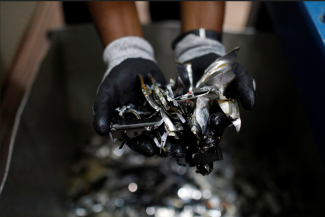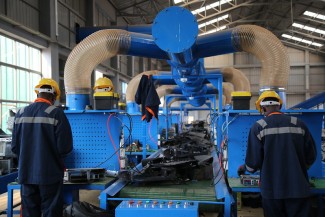Ensuring universal access to energy will constitute a major challenge for least developed countries. What are the key considerations that these countries should keep in mind as they deploy efforts towards meeting this objective?
Originally published in Bridges Africa, Volume 7 - Number 3
As “sustainable and modern energy” continues to feature prominently in the development discourse and the global shift towards low-carbon energy system gains momentum, the specific situation of the least developed countries (LDCs) warrants deeper consideration. Representing 13 percent of the world’s population, these countries account for the majority of people lacking access to electricity (54 percent in 2014), and will thus largely determine whether the objective of universal energy access enshrined in Sustainable Development Goal (SDG) 7 will be achieved or missed. Although the levels of installed capacity and electricity production have been on the rise for the last 15-20 years in LDCs, they have so far failed to catch up with mounting demand. The “electricity divide” between LDCs and the rest of the world has actually widened, to the extent that in 2014, electricity production per capita was less than a third of the world average (3,290 kilowatt hour) in all LDCs but Bhutan (Figure 1).[1]
Figure 1: Gross electricity production in the LDCs (production per capita, growth rate, and share of renewables)

Source: Author’s calculation based on data from UNCTAD 2017
Against this background, considerations related to the virtues of renewable energy for climate change mitigation are unlikely to play a decisive role for LDCs, given that they account for a negligible share of historical CO2 emissions, display extremely low levels of energy consumption per capita, and in many cases already have a low-carbon power sector thanks to hydroelectric dams. A more fundamental issue, from an LDC perspective, is rather the extent to which technological innovations and the improving cost-competitiveness of (mainly non-hydro) renewables can be harnessed to boost their power sectors.
In this context, national and international investors are increasingly eyeing viable business opportunities to scale up renewable energy generation in developing countries, Africa being often touted as a lucrative frontier market. Many developing countries themselves have bet on the potential of renewable energy. In the context of the COP 22 of the UN Framework Convention on Climate Change, for example, the members of the Climate Vulnerable Forum (a coalition encompassing 24 LDCs) have pledged to achieve 100 percent domestic renewable energy production by 2050. Whilst these developments are promising, exploiting the transformational opportunities offered by renewables will require a sound and proactive policy framework capable of shaping the evolution of the power sector in a predictable way, as well as concerted policy efforts at the local, national, and international levels.
The remainder of this article is structured as follows. The next section presents key strategic considerations with respect to the opportunities that renewable energy sources may bring about in the context of LDCs’ development efforts. The following one highlights the main challenges related to technology transfer, which will be required for scaling up the deployment of renewable generation technologies. The final section outlines some broad policy recommendations.
THE STRATEGIC DIMENSIONS OF RENEWABLES FOR LDCS
Worldwide, the deployment of renewables has accelerated significantly over the last few years, and this trend is set to continue. The International Energy Agency estimates that in 2016, renewable energy sources accounted for almost two-thirds of new net capacity additions, with solar photovoltaic (PV) and wind claiming the lion’s share of this increase.[2] In LDCs, unlike in other developing countries (notably China and India), the penetration of non-hydro renewables is still an incipient phenomenon, mainly confined to smaller-scale plants. Nevertheless, the process is rapidly getting traction. In the last few years, utility-scale solar and wind farms have come online in a number of LDCs, with countries like Ethiopia, Laos, and Senegal leading the way. As this trend gains momentum and learning effects push further down the cost of renewable energy technologies, a few strategic considerations are warranted.
From an LDC perspective, the economic rationale underpinning the growing appeal of renewables rests on four main elements.
First, most LDCs are characterised by vast and largely untapped energy resource potential, not only for hydro-electricity, but also for solar, wind, bioenergy, and – in some cases – geothermal generation. As technological progress broadens the array of commercially viable technologies, more options become available to realise their theoretical resource potential, and boost electricity production and access. In this respect, LDCs could also benefit from a “latecomer advantage”: they can leverage their renewable energy potential without incurring large costs for retrofitting existing infrastructures, but rather by gradually integrating renewables into their system.
Secondly, renewable energy technologies (such as solar PV, mini-hydro, or even biomass generators using agricultural wastes) lend themselves well to the kind of decentralised generation which could spur rural electrification where the costs of grid extension remain prohibitive. Considering that 82 percent of the people lacking access to electricity in LDCs live in rural areas, the deployment of renewable-based or hybrid mini-grids and other off-grid technologies thus promises to have a transformational effect, facilitating the emergence of higher productivity rural non-farming activities.
Thirdly, a strong renewable energy sector might open the scope for fostering the establishment of stronger and more viable energy value chains through backward and forward linkages, including not only the manufacturing and assembling of renewable energy technologies, but also installation, maintenance, and repair services. Fourthly, except in the case of countries endowed with fossil fuel reserves, on the medium-term a gradual transition towards low-carbon energy sources might help reducing the import bill for fuels, thus alleviating balance of payment difficulties.[3]
Beyond the purely economic sphere, a greater penetration of renewable-based technologies might be helpful also from an energy security point of view. Most LDCs have historically relied on variable combinations of fossil fuel and hydroelectric plants for their power generation, with a number of them being entirely dependent on one of these sources only.[4] In this context, technological advances in (mainly non-hydro) renewable energy technologies could pave the way for greater diversification of the power generation mix, enhancing system resilience. The relevance of these considerations is set to increase as the impact of climate change becomes more visible, as highlighted by the recent experience of Zambia, which turned to solar as its hydro-based electricity production plummeted due to severe drought.
THE CHALLENGES OF TECHNOLOGY TRANSFER
While the above factors will plausibly play a key role in the long term, leading to a gradual and more varied penetration of renewable energy technologies in the LDCs, one cannot take for granted a smooth process of technological diffusion. Nor is the pace of such a transition likely to be in line with international targets if left to the spontaneous workings of the market. Meeting SDG 7 will undoubtedly require daunting financial efforts, regardless of the suite of technologies considered. Estimates of the cost of attaining universal electricity access range, in the case of LDCs, from US$12 to US$40 billion annually. With development assistance to energy-related sectors in LDCs falling short of US$3 billion in 2016, and in view of the looming concerns about LDCs’ debt sustainability, the quest for development finance is set to remain the top priority.
This situation is exacerbated by the fact that renewable energy technologies are typically characterised by large upfront capital expenditures. Therefore, LDCs’ tight financing conditions (and higher perceived risk) end up weighing down their competitiveness vis-à-vis alternative options. Moreover, while international costs of renewable-based electricity are declining (especially for solar PV), varying local conditions imply large heterogeneity across countries, meaning that technologies which are commercially viable in some contexts may not yet be competitive in many LDCs.[5]
Equally important, for an industry characterised by scale economies and large variations between peak and off-peak load, the viability of investments is constrained by the size (and time-profile) of demand. The limited purchasing power of consumers in LDCs, coupled with the low levels of energy demand for productive purposes, thus translate into challenging market conditions, whereby prospective investors have to balance scale economies considerations with the risk of low capacity utilisation. In this context, the need to reconcile affordability and financial sustainability cannot but affect the way in which utilities and policymakers engage private investors and independent power producers. If the involvement of the latter has proved beneficial to accelerate renewables’ deployment, on the other hand, the sustainability of the underlying business models has also been questioned. The political economy dimension of private sector participation, including with reference to the terms of power purchase agreements, deserves particular scrutiny in view of the potential for market power or natural monopoly situations.[6]
Moreover, as renewables’ performance is often contingent on local conditions (solar irradiation, wind-speed, etc.), their deployment cannot but rely on systematic mapping of LDCs’ resource potential, careful planning and designing, and sound operation and management. This is compounded, in the case of variable renewables (i.e. solar or wind), with the need to devote additional resources to cope with their intrinsic variability, by enhancing and effectively managing system flexibility through storage, better transmission networks, demand management, etc. In this context, if becoming “early adopters” of advanced renewable energy technologies may indeed offer LDCs some scope for leap-frogging – decentralised generation and smart-grids being a case in point –, the multifaceted complexity of energy systems makes the acquisition of know-how and technological adaptation all the more critical. Moreover, technology diffusion is affected by absorptive capacities both at local level (for instance by decentralised power producers or mini-grids operators) and within specialised institutions (like planning authorities, system operators, and energy research centres).
To date, of the four main channels for technology transfer and acquisition – namely trade, foreign direct investment, licensing, and labour mobility – international trade has been by far the most relevant for LDCs in relation to energy technologies. The more than doubling of net installed capacity taking place in LDCs over the last 10-15 years has been accompanied by a fourfold increase in the imports of power generating machinery and equipment.[7] Around half of these flows (and 70 percent of imports of electrical end-use machinery and appliances) originated in other developing countries, highlighting the growing relevance of South-South trade as a vehicle for energy-related technology transfer, with China being the main (but not only) driver of this trend.
While burgeoning trade flows confirm the dynamism of investment in energy sectors, renewables will not unleash their full development potential unless LDCs are able to move beyond pure technology acquisition and into adaptation and related innovation. From this perspective, notwithstanding some encouraging signs, the track record remains rather inadequate, due to the weakness of local absorptive capacities in relation to a rapidly evolving and increasingly technology-intensive sector, as well as to the lack of effective international support measures.
THE WAY AHEAD
The incipient penetration of non-hydro renewables in LDCs is consistent with past energy transitions, whereby the penetration of new technologies required a relatively long initial period of adaptation and cost discovery before larger-scale deployment. Nonetheless, more needs to be done if LDCs are to achieve universal access to sustainable and modern energy (SDG 7) and reap broader developmental benefits from a gradual shift towards low-carbon energy systems.
With this objective in mind, LDCs may consider the following priorities for their energy policy framework:
- Developing a sound and predictable system-wide planning for the power sector, to shape its long-term evolution in a coherent manner (including through harmonised standards to ensure interoperability), while fully exploiting synergies and complementarities across different technologies;
- Leveraging the modularity of renewable energy technologies (especially in the context of decentralised generation), and more generally adopting forward-looking approaches to future energy needs, in order to minimise the risks of technological lock-in and enhance system flexibility;
- Fully integrating modern energy access into development strategies, with a view to foster productive energy uses and give rise to a virtuous circle between energy supply and demand;
- Adopting a strategic approach to trade and investment issues, including by harnessing regional integration (notably power pools) and South-South cooperation with a view to strengthening system resilience, as well as absorptive capacities and local innovation systems.
Needless to say, the international community also has an essential role to play in supporting the achievement of SDG 7, and the global transition to low-carbon energy systems. In particular, three areas of intervention stand out in relation to LDCs. First, there is a need for greater provision of aid and technical assistance to the energy-related sectors in LDCs, in line with long-standing international targets. Second, more effective forms of international support are warranted to facilitate the transfer of clean energy technologies to the benefit of LDCs (including through the recently established Technology Bank for LDCs). Finally, it is also crucial to increase the availability of de-risking instruments to facilitate the crowding-in of private financial resources while keeping in check LDCs’ levels of indebtedness.
-------
This article is based on chapter 3 of UNCTAD’s Least Developed Countries Report 2017: Transformational Energy Access.
Author: Giovanni Valensisi, Economic Affairs Officer, United Nations Conference on Trade and Development.
[1] UNCTAD. The Least Developed Countries Report 2017: Transformational Energy Access. New York and Geneva: United Nations, 2017.
[2] International Energy Agency (IEA). Medium-Term Renewable Energy Market Report 2017. Paris: OECD/IEA, 2017.
[3] This consideration is particularly relevant for small island LDCs, most of which are entirely reliant on imported oil products for their electricity generation. See UNCTAD, op cit.
[4] Ibid.
[5] Offshore wind and concentrated solar power provide instructive examples in this respect.
[6] Anton A. Eberhard et al. Independent Power Projects in Sub-Saharan Africa: Lessons from Five Key Countries. Directions in Development Energy and Mining. Washington, DC: World Bank Group, 2016.
[7] UNCTAD, op.cit.
Header image of shea kernels at a women-run processing centre in Tanghin Dassouri, Burkina Faso - ©DelphicomAfrique/EIF. Image of Kora N'gobi Mouniratou and her shea - ©Global Shea Alliance.
If you would like to reuse any material published here, please let us know by sending an email to EIF Communications: eifcommunications@wto.org.



